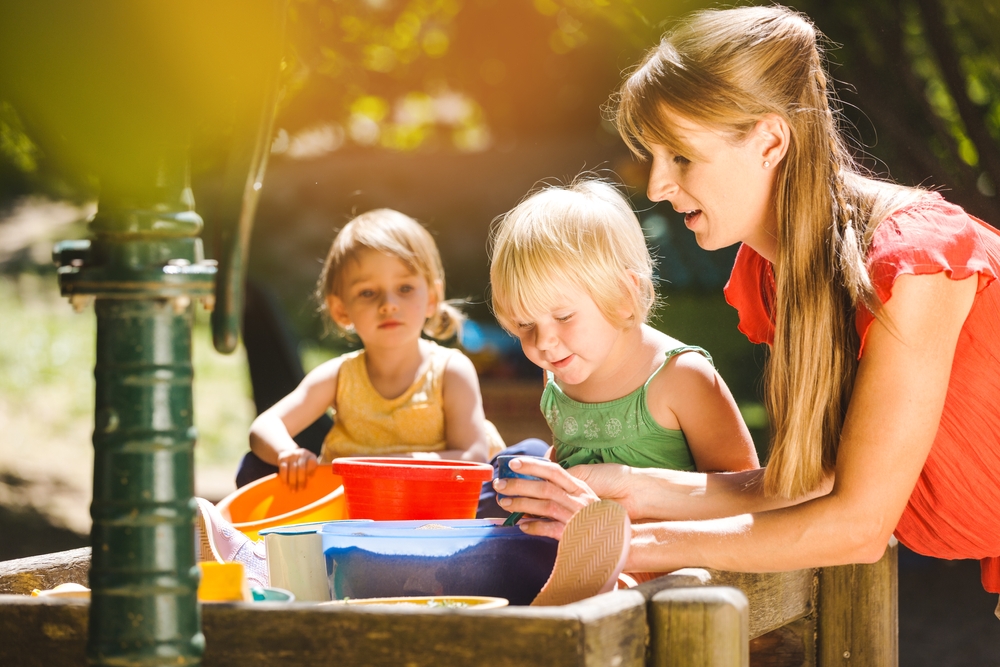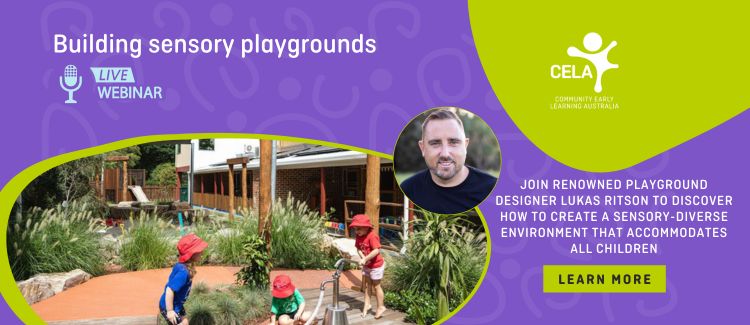By Janelle Gallagher, CELA early education specialist and former preschool director
The Early Years Learning Framework V2 has expanded upon the principle of high expectation and equity, including a focus on inclusion. This recognises and reinforces the right of all children to participate in high-quality and inclusive early childhood settings, regardless of circumstances, strengths, gender, capabilities, or diverse ways of doing and being.
This is a far cry from previous practices when children with a diagnosis were often excluded, sometimes unintentionally, from participating in play; for example, the child was unable to sit in the sand pit unless an adult provided support. While the diagnosis gave educators certainty on how best to help children, it also created barriers. Children were often interrupted by a professional who had a planned session scheduled to address their “needs”, taking them away from the play in which they were immersed.
Often the child protested. Some went quietly, resigned to compliance, while others expressed their displeasure loudly.
And why wouldn’t they?
Unfortunately, this may still be happening in many settings today.
The start of my critical reflection journey
Repeated observations of children being taken away from their play and peers to participate in therapy led me to question what was happening for the child at that moment.
- How would this feel to the child?
- Is this in this child’s best interests?
- What is the child learning from this exchange?
Unbeknownst to me, this was the start of my critical reflection journey, a term I was then unfamiliar with.
Foucault’s (1997) incitement to question what we think we know and to trouble the “regimes of truth” that govern us provides a framework to critique medical disciplines and the practices of special education in the classroom.
The realisation that I knew the child’s disability better than I knew the child was horrifying.
Presence does not equal inclusion: removing my “disability lens” to view the whole child
This led me to remove my disability lens and view the child as capable and competent.
My practices were put under the microscope, bringing new thinking and ideas into focus and allowing the exploration of the “known truths”. These known truths were informed by developmental theory and discourse, where my role was to try and help.
I did not see the child beyond their disability.
It required courage to pose tough questions and to sit in the unknown,
courage to be comfortable in the uncomfortable,
time to develop a listening map capturing my internal thoughts, which would inform new principles and practices.
Emerging from this hiatus, I realised a child’s presence in a centre does not equal inclusion. For children to be included and fully participate in their learning, they must be able to exercise their right to be heard and have agency over their learning. I engaged my team in this reflection. We questioned the notion of shadowing children and employing educators to work 1:1 with children where possible. Still, safety was paramount for children with complex medical conditions and needs and the team remained vigilant in their supervision.
Moving to a play-based pedagogy for therapy
Children need access to therapy, and we always acknowledged that. However, we moved to using play-based pedagogy rather than a therapy approach. Incorporating a play-based pedagogy for therapy involves other children and educators intentionally building the skills into the experience.
One example could be during water play, where the child fills the bucket and pours water into the mud, creating a beautiful sensory experience. Meanwhile, the child has used their big muscles to lift the heavy bucket, a friend has helped steady the other vessel, and together they begin making mud. They are talking to each other as they manipulate the coarse, lumpy mud while their fingers are squashing and squeezing the mixture into a cake or a meatball. All of the child's goals have been met, and more! The child is being social; they have had an opportunity to negotiate and take turns, using language to express thoughts and ideas. The speech therapist may be there introducing new concepts into the play annd the child has a sense of belonging. The play continues, and often the child returns to this space to practice the new skills at a later date. The child has agency over their own learning.
.jpg?width=750&height=500)
Thankfully, Australia became a signatory to the United Nations Convention on the Rights of the Child in December 1990, which coincided with my awakening. With the signing of the Convention, children were recognised as rights holders. As a result, children have a right to say what they want, and adults must listen.
A new vision for our service and a reputation for inclusion
Our new vision required a team effort to build capacity for all educators and teachers. It was important to hire people who shared our vision of high-quality early education for every child. Many didn’t have the formal qualifications, but they were passionate and willing to learn.
Our philosophy was updated to focus on supporting children's rights.
Our practices and environment changed, enabling all children to make decisions about where they played and with whom. Children were consulted about where pathways should be laid in the playground, and more of the outdoor areas became truly accessible, enabling all children to make independent decisions about where they wanted to play.
The word began to spread throughout our community that our service successfully supported all children, and our enrolments of children with a diagnosis increased. Therapists and specialised inclusion teachers observed children’s progress, both academically and in their connection to their peers.
We consulted with children and families. The way we communicated with children was examined and reviewed. Every piece of equipment, including bikes, furniture, tools, e.g. scissors, and drawing implements, were explored. Other professionals assessed our environment, helping us to develop a safe workplace for educators. The list was endless and required constant reflection to ensure each child’s participation in the program.
Our innovative play-based model ensured that all children’s wishes and agency were honoured. Families, clinicians and early childhood professionals worked alongside each other in partnership and collaboration. As a result, all children benefited, educators learned new skills, and allied health professionals explored new ways of working in natural settings. We no longer needed a tool kit of special resources; we were using familiar, everyday materials with children.
The perceived constraints were no longer viewed as problems; instead, they opened possibilities. The community took great interest in our work, and the early childhood profession consulted with us.
Carla Rinaldi (2013) states:
An educating community is a community, a city, where early childhood centres and schools play a key and crucial role. The role they play is not only for learning formal knowledge by children but for learning values on which the community itself bases its identity and can reflect on the moral aspect of becoming a citizen and a worker in and of a society. For example, a school that gives time to all expects time to be given by all to the society.
Tommy’s* story—fulfilling a mother’s vision of education equity for her child
One January, I received a call from a parent seeking a position for her son, who had complex needs. I listened intently as she shared their story, echoing her love through the rawness and strength only a mother can feel when retelling their journey. She was vulnerable but clear. She had a vision and wanted her child to be afforded what was a “given” for every other child; the right to attend preschool with his peers.
I agreed.
What followed for all of us was a journey full of surprises, challenges, successes, trials, and lifelong learning and friendship. Together we navigated environmental changes to ensure wheelchair access to every part of the building and playground. Modifications were made (by the child’s grandfather) to the wheelchair to enable peers to be at the same height and enable the child to experience everything the curriculum offered. Technology was explored through knowledgeable others and introduced as a communication tool for all children. I vividly recall children seeking assistance to communicate with Tommy and give him a voice—“But Jannelle, he can’t speak,” they would say. “Then we need to learn to listen differently,” I responded.
We learnt to listen by using our senses. We introduced visuals and assisted technology like the Jellybean Switch (the Jelly Bean is a simple mechanical switch that can control speech-generating devices, toys, environmental control units and computers).
At five years of age, this young man chose a mainstream education. He did not want to be segregated. Today he is 26 years old, fully participates in his community, and has a voice.
I am still in touch with this family and recently contacted his mother, Sharon. Reflecting on this time, Sharon told me: “Everyone deserves to have a good life, a quality of life, and to be accepted and valued in the community.”
*Permission to share this story was sought and given by the parent and young adult who gave me so much and guided me on our journey.
________________________
Over the years, many children and their families taught us so much. We honoured families' trust in us to ensure their children enjoyed the freedom of being, belonging, and becoming.
Australia has joined other countries globally to promote equal and active participation of all people with disability. The early childhood sector has embraced this vision by strengthening the connection between the EYLF (V2.0) and the National Quality Standard in many areas, including inclusion.
How will this principle of equity, inclusion, and high expectation challenge your daily practices?
Here are some tips for getting started on your path to inclusion:
-
Services often will doubt their capability. When you work with parents and carers, parents are the child’s first teacher; they have valuable insight into their child. Educators can become more attuned to the child by developing a strong relationship with the parents or carers.
-
Assess the skills your staff already have. Where are the gaps in our knowledge and practice?
-
Who can assist in developing these skills?
-
Find research to assist in developing educator thinking
-
Become familiar with the legislation
-
Never lose sight of the “why”
Here's a great video from the Victorian Inclusion Agency:
Upcoming professional development relating to this topic

FIND OUT MORE
References
Foucault, M. (1977). Discipline and punish: The birth of the prison. London, England: Penguin.
Reimagining Early Childhood: The inspiration of Reggio Emilia education principles in South Australia (2013).
Watson, K. 2017. Inside the ‘inclusive’ early childhood classroom: The power of the 'normal’. New York.
Australian Research Alliance for Children and Youth. (2014). Inclusive education for students with disability: A review of the best evidence in relation to theory and practice. Retrieved from https://www.aracy.org.au/publications-resources/command/download_file/id/235/filename/Inclusive_education_for_students_with_disability-A_review_of_the_best_evidence_in_relation_to_theory_and_practice.pdf.
Early Childhood Intervention Australia Victoria/Tasmania. (n.d.). Providing supports in everyday environments. Retrieved from https://www.eciavic.org.au/resources/providing-supports-in-everyday-environments
Useful resources
New South Wales Department of Education. (2018). Literature review: Professional development for the early childhood education workforce to better include children with additional needs. https://education.nsw.gov.au/content/dam/main-education/early-childhood-education/operating-an-early-childhood-education-service/media/documents/LiteratureReview-PDSP.PDF
Inclusion Agency NSW/ACT. (n.d.). The Inclusion Support Program. https://inclusionagencynswact.org.au/about/the-inclusion-support-program
Reimagine Australia. (n.d.). Inclusion in practice. https://reimagine.org.au/practitioner/inclusion-in-practice/